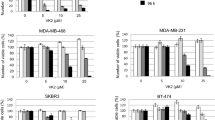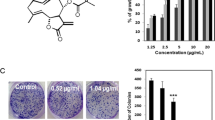Abstract
Purpose
We examined the growth-inhibitory and apoptosis-inducing effects of vitamin K2 (VK2; menaquinone-4) on various lines of human ovarian cancer cells to study the mechanism of induction of apoptosis by VK2.
Methods
Cell proliferation was determined by XTT method, and apoptotic cells were detected by Hoechst staining. TR3, also known as Nur77 and NGFI-B, was detected by immunoblotting and immunofluorescence analysis. Role of TR3 on induction of apoptosis was examined by a siRNA experiment.
Results and conclusions
We found that PA-1 cells were the most sensitive to VK2 (IC50 = 5.0 ± 0.7 μM), while SK-OV-3 cells were resistant to VK2. Immunoblotting and immunofluorescence analyses indicated that levels of TR3 were elevated in cell lysates 48 h after the start of treatment with 30 μM VK2. In the VK2-treated cells, TR3 accumulated at significant levels in mitochondria, as well as in the nuclei of PA-1 cells. No similar changes were observed in SK-OV-3 cells under the same conditions. Treatment of PA-1 cells with small interfering RNA (siRNA) directed against TR3, and with cycloheximide or SP600125 (an inhibitor of c-jun N-terminal kinase; JNK), separately, inhibited the VK2-induced synthesis of TR3 and apoptosis. From these results, we can conclude that an increase in the synthesis of TR3 and the accumulation of TR3 in mitochondria and in nuclei might be involved in the induction of apoptosis by VK2 and that the synthesis of TR3 might be regulated through a JNK signaling pathway.









Similar content being viewed by others
Abbreviations
- BSA:
-
Bovine serum albumin
- CHX:
-
Cycloheximide
- FBS:
-
Fetal bovine serum
- GAPDH:
-
Glyceraldehyde-3-phosphate dehydrogenase
- HM:
-
Heavy membrane
- JNK:
-
c-Jun N-terminal kinase
- NGFI-B:
-
Nerve growth factor induced clone B
- OX:
-
Cytochrome oxidase subunit IV
- PBS:
-
Phosphate-buffered saline
- PMSF:
-
Phenylmethylsulfonyl fluoride
- ROS:
-
Reactive oxygen species
- siRNA:
-
Small interfering RNA
- TBS:
-
Tris-buffered saline
- TPA:
-
Tetradecanoylphorbol-1,3-acetate
- VK2 :
-
Vitamin K2
- XTT:
-
Sodium-3'-[1-[(phenylamino)carbonyl]-3,4-tetrazolium-bis(4-methoxy-6-nitro)benzene-sulfonic acid hydrate
References
Bernardini S, Berassola F, Cortese C, Ballerini S, Melino G, Motti C, Bellincampi L, Iori R, Federici G (2000) Modulation of GST P1-1 activity by polymerization during apoptosis. J Cell Biochem 77:645–653
Cao X, Liu W, Lin F, Li H, Kulluri SK, Lin B, Han Y, Dawson MI, Zhang X (2004) Retinoid receptor regulates Nur77/thyroid hormone receptor 3-dependent apoptosis by modulating its nuclear export and mitochondrial targeting. Mol Cell Biol 24:9705–9725
Chen YR, Shrivastava A, Tan TH (2001) Down-regulation of the c-Jun N-terminal kinase (JNK) phosphatase M3/6 and activation of JNK by hydrogen peroxide and pyrrolidine dithiocarbamate. Oncogene 16:367–374
Conde de la Rosa L, Schoemaker MH, Vrenken TE, Buist-Homan M, Havinga R, Jansen PL, Moshage H (2006) Superoxide anions and hydrogen peroxide induce hepatocyte death by different mechanisms: involvement of JNK and ERK MAP kinases. J Hepatol 44:918–929
Davis RJ (2000) Signal transduction by the JNK group of MAP kinases. Cell 103:239–252
Han YH, Cao X, Lin B, Kolluri SK, Stebbins J, Reed JC, Dawson MI, Zhang XK (2006) Regulation of Nur77 nuclear export by c-Jun N-terminal kinase and Akt. Oncogene 18:2974–2986
Hazel TG, Nathans D, Lau LF (1988) A gene inducible by serum growth factors encodes a member of the steroid and thyroid hormone receptor superfamily. Proc Natl Acad Sci USA 85:8444–8448
Herschman HR (1991) Primary response genes induced by growth factors and tumor promoters. Annu Rev Biochem 60:281–319
Hitomi M, Yokoyama F, Kita Y (2005) Antitumor effects of vitamin K1, K2 and K3 on hepatocellular carcinoma in vitro and in vivo. Int J Oncol 26:713–720
Holmes WF, Soprano DR, Soprano KJ (2002) Elucidation of molecular events mediating induction of apoptosis by synthetic retinoids using a CD437-resistant ovarian carcinoma cell line. J Biol Chem 277:45408–45419
Holmes WF, Soprano DR, Soprano KJ (2003a) Early events in the induction of apoptosis in ovarian carcinoma cells by CD437: activation of the p38 MAP kinase signal pathway. Oncogene 22:6377–6386
Holmes WF, Soprano DP, Soprano KJ (2003b) Comparison of the mechanism of induction of apoptosis in ovarian carcinoma cells by the conformationally restricted synthetic retinoids CD437 and 4-HPR. J Cell Biochem 89:262–278
Iwamoto J, Takeda T, Sato Y (2004) Effects of vitamin K2 on osteoporosis. Curr Pharm Res 10:2557–2576
John D. Woronics JD, Xallan B, Ngo V, Astar W (1994) Requirement for orphan steroid receptor Nur77 in apoptosis of T-cell hybridomas. Nature 367:277–281
Katagiri Y, Takeda K, Yu Z-X, Ferrans VJ, Ozato K, Guroff G (2000) Modulation of retinoid signalling through NGF-induced nuclear export of NGFI-B. Nat Cell Biol 2:435–440
Kolluri SK, Bruey-Sedano N, Cao X, Lin B, Lin F, Han YH, Dawson MI, Zhang XK (2003) Mitogenic effect of orphan receptor TR3 and its regulation by MEKK1 in lung cancer cells. Mol Cell Biol 23:8651–8667
Kudo N, Matsumori N, Taoka H, Fujiwara D, Schreiner EP, Wolff B, Yoshida M, Horinouchi S (1999) Leptomycin B inactivates CRM1/exportin by covalent modification at a cysteine residue in the central conserved region. Proc Natl Acad Sci USA 96:9112–9117
Laemmli UK (1970) Cleavage of structural proteins during the assembly of the head of bacteriophage T4. Nature 227:680–685
Li H, Kolluri SK, Gu J, Dawson MI, Cao X, Hobbs PD, Lin B, Chen G, Lu J, Lin F, Xie Z, Fontana JA, Reed JC, Zhang X, (2000) Cytochrome c release and apoptosis induced by mitochondrial targeting of nuclear orphan receptor TR3. Science 289:1159–1164
Li Y, Lin B, Agadir A, Liu R, Dawson MI, Reed JC, Fontana JA, Bost F, Hobbs PD, Zheng Y, Chen GQ, Shroot B, Mercola D, Zhang XK. (1998) Molecular determinants of AHPN (CD437)-induced growth arrest and apoptosis in human lung cancer cell lines. Mol Cell Biol 18:4719–4731
Lin B, Kolluri SK, Lin F, Liu W, Han Y-H, Cao X, Dawson MI, Reed JC, Zhang X-K (2004a) Conversion of Bcl-2 from protector to killer by interaction with nuclear orphan receptor Nur77/TR3. Cell 116:527–540
Lin X-F, Zhao B-X, Chen H-Z, Ye X-F, Yang C-Y, Zhou H-Y, Zhang M-Q, Lin S-C, Wu Q (2004b) RXRα acts as a carrier for TR3 nuclear export in a 9-cis retinoic acid-dependent manner in gastric cancer cells. J Cell Sci 117:5609–5621
Lo YY, Wong JM, Cruz TF (1996) Reactive oxygen species mediate cytokine activation of c-Jun NH2-terminal kinases. J Biol Chem 271:15703–15707
MacFarlane M, Cohen GM, Dickens M (2000) JNK (c-Jun-terminal kinase) and p38 activation in receptor-mediated and chemically induced apoptosis of T-cells: differential requirements for caspase activation. Biochem J 348:93–101
Miyazawa K, Yaguchi M, Funato K, Gotoh A, Kawanishi Y, Nishizawa Y, Yuo A, Ohyashiki K (2001) Apoptosis/differentiation-inducing effects of vitamin K2 on HL-60 cells: dichotomous nature of vitamin K2 in leukemia cells. Leukemia 15:1111–1117
Nakai A, Kartha S, Sakurai A, Toback FG, DeGroot LJ (1990) A human early response gene homologous to murine nur77 and rat NGFI-B, and related to the nuclear receptor superfamily. Mol Endocrinol 4:1438–1443
Nishikawa Y, Carr BI, Wang M, Kar S, Finn F, Dowd P, Zheng ZB, Kerns J, Naganathan S (1995) Growth inhibition of hepatoma cells induced by vitamin K and its analogs. J Biol Chem 270:28304–28310
Pekarsky Y, Hallas C, Palamarchuk A, Koval A, Bullrich F, Hirata Y, Bichi R, Letofsky J, Croce CM (2001) Akt phosphorylates and regulates the orphan nuclear receptor Nur77. Proc Natl Acad Sci USA 98:3690–3694
Roehm NW, Rodgers GH, Hatfield SM, Glasebrook AL (1991) An improved colorimetric assay for cell proliferation and viability utilizing the tetrazolium salt XTT. J Immunol Methods 142:257–265
Ryseck RP, Macdonald-Bravo H, Mattei MG, Ruppert S, Bravo R (1989) Structure, mapping and expression of a growth factor inducible gene encoding a putative nuclear hormonal binding receptor. EMBO J 8:3327–3335
Sakai I, Hashimoto S, Yoda M, Hida T, Ohsawa S, Nakajo S, Nakaya K (1994) Novel role of vitamin K2: a potent inducer of differentiation of various human myeloid leukemia cell lines. Biochem Biophys Res Commun 205:1305–1310
Shibayama-Imazu T, Sakairi S, Watanabe A, Aiuchi T, Nakajo S, Nakaya K (2003) Vitamin K2 selectively induced apoptosis in ovarian TYK-nu and pancreatic MIA Paca-2 cells out of eight solid tumor cell lines through a mechanism different from geranylgeraniol. J Cancer Res Clin Oncol 129:1–11
Shibayama-Imazu T, Sonoda I, Sakairi S, Aiuchi T, Wei-wei A, Nakajo S, Itabe H, Nakaya K (2006) Production of superoxide and dissipation of mitochondrial transmembrane potential by vitamin K2 trigger apoptosis in human ovarian cancer TYK-nu cells. Apoptosis 11:1535–1543
Tournier C, Hess P, Yang DD, Xu J, Turner TK, Nimnual A, Bar-Sagi D, Jones SN, Flavell RA, Davis RJ (2000) Requirement of JNK for stress-induced activation of the cytochrome c-mediated death pathways. Science 288:870–874
Uemura H, Chang C (1998) Antisense TR3 orphan receptor can increase prostate cancer cell viability with etoposide treatment. Endocrinology 139:2329–2334
Wang Z, Wang M, Finn F, Carr BI (1995) The growth-inhibitory effects of vitamin K and their actions on gene expression. Hepatology 22:876–882
Weih F, Ryseck P, Chen L, Bravo R (1996) Apoptosis of nur77/N10-transgenic thymocytes involves the Fas/Fas ligand pathway. Pro Natl Acad Sci USA 93:5533–5538
Wilson AJ, Arango D, Mariadason JM, Heerdt BG, Augenlicht LH (2003) TR3/Nur77 in colon cancer cell apoptosis. Cancer Res 63:5401–5407
Wu Q, Liu S, Ye X-F, Huang Z-W, Su W-J (2002) Dual roles of Nur77/N10 in selective regulation of apoptosis and cell cycle by TPA and ATRA in gastric cancer cells. Carcinogenesis (Lond) 23:1583–1592
Wu Q, Li Y, Liu R, Agadir M, Lee O, Liu Y, Zhang X (1997) Modulation of retinoic acid sensitivity in lung cancer cells through dynamic balance of orphan receptors nur77 and COUP-TF and their heterodimerization. EMBO J 16:1656–1669
Xue Y, Chomez E, Castanos-Velez E, Biberfeld P, Perlmann T, Jondal M (1997) Positive and negative thymic selection in T cell receptor-transgenic mice correlate with Nur77 mRNA expression. Eur J Immunol 27:2048–2056 [erratum in Eur J Immunol 27:2748]
Yaguchi M, Miyazawa K, Katagiri T, Nishimaki J, Kizaki M, Tohyama K, Toyama K (1997) Vitamin K2 and its derivatives induce apoptosis in leukemia cells and enhance the effect of all-trans retinoic acid. Leukemia 11:779–787
Yoshida T, Miyazawa K, Kasuga I, Yokoyama T, Minemura K, Ustumi K, Aoshima M, Ohyashiki K (2003) Apoptosis induction of vitamin K2 in lung carcinoma cell lines: the possibility of vitamin K2 therapy for lung cancer. Int J Oncol 23:627–632
Author information
Authors and Affiliations
Corresponding author
Rights and permissions
About this article
Cite this article
Sibayama-Imazu, T., Fujisawa, Y., Masuda, Y. et al. Induction of apoptosis in PA-1 ovarian cancer cells by vitamin K2 is associated with an increase in the level of TR3/Nur77 and its accumulation in mitochondria and nuclei. J Cancer Res Clin Oncol 134, 803–812 (2008). https://doi.org/10.1007/s00432-007-0349-z
Received:
Accepted:
Published:
Issue Date:
DOI: https://doi.org/10.1007/s00432-007-0349-z




